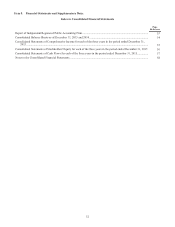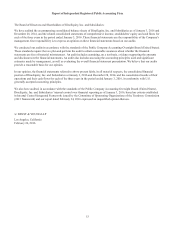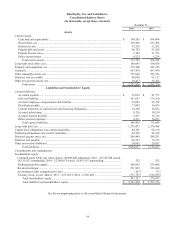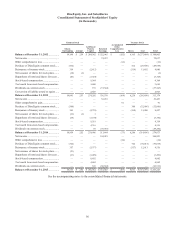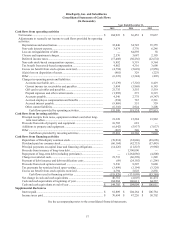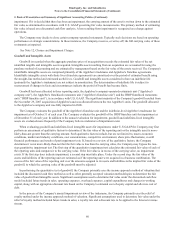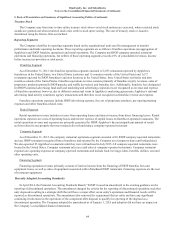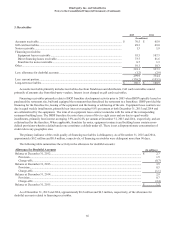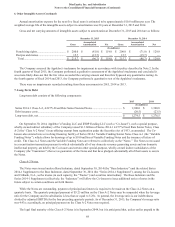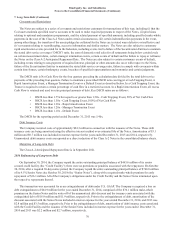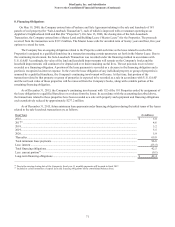IHOP 2015 Annual Report Download - page 81
Download and view the complete annual report
Please find page 81 of the 2015 IHOP annual report below. You can navigate through the pages in the report by either clicking on the pages listed below, or by using the keyword search tool below to find specific information within the annual report.DineEquity, Inc. and Subsidiaries
Notes to the Consolidated Financial Statements (Continued)
2. Basis of Presentation and Summary of Significant Accounting Policies (Continued)
61
Revenue Recognition
The Company's revenues are recorded in four categories: franchise operations, company restaurant operations, rental
operations and financing operations.
Franchise operations revenue consists primarily of royalty revenues, sales of proprietary IHOP products, IHOP advertising
fees and franchise fees. Rental operations revenue includes revenue from operating leases and interest income from direct
financing leases. Company restaurant sales are retail sales at company-operated restaurants. Financing operations revenue
consists primarily of interest income from the financing of franchise fees and equipment leases, as well as sales of equipment
associated with refranchised IHOP restaurants.
Revenues from franchised and area licensed restaurants include royalties, continuing rent and service fees and initial
franchise fees. Royalties are recognized in the period in which the sales are reported to have been earned, which occurs at the
franchisees' point of sale. Continuing rent and fees are recognized in the period earned. Initial franchise fees are recognized
upon the opening of a restaurant, which is when the Company has performed substantially all initial services required by the
franchise agreement. Fees from development agreements are deferred and recorded into income as restaurants under the
development agreement are opened. Sales by company-operated restaurants are recognized when food and beverage items are
sold. Company restaurant sales are reported net of sales taxes collected from guests that are remitted to the appropriate taxing
authorities.
The Company records a liability in the period in which a gift card is sold and recognizes costs associated with our
administration of the gift card programs as prepaid assets when the costs are incurred. As gift cards are redeemed, the liability
and prepaid asset are reduced. When gift cards are redeemed at a franchisee-operated restaurant, the revenue and related
administrative costs are recognized by the franchisee. The Company recognizes revenue and related administrative costs when
gift cards are redeemed at company-operated restaurants. The Company recognizes gift card breakage income on gift cards
when the assessment of the likelihood of redemption of the gift card becomes remote. This assessment is based upon
Applebee's and IHOP's individual historical experience with gift card redemptions in their own program. The Company's gift
card breakage revenue for the years ended December 31, 2015, 2014 and 2013 was not material.
Allowance for Credit Losses
The allowance for doubtful accounts is the Company's best estimate of the amount of probable credit losses in existing
receivables; however, changes in circumstances relating to receivables may result in changes to the allowance in the future. The
Company determines the allowance based on historical experience, current payment patterns, future obligations and the
Company's assessment of the franchisee's or area licensee's ability to pay outstanding balances. The primary indicator of credit
quality is delinquency, which is considered to be a receivable balance greater than 90 days past due. The Company continually
reviews the allowance for doubtful accounts. Past due balances and future obligations are reviewed individually for
collectability. Account balances are charged against the allowance after all collection efforts have been exhausted and the
potential for recovery is considered remote. Credit losses historically have been within management's expectations.
Leases
The Company is the lessor or sub-lessor of the properties on which 696 IHOP restaurants and four Applebee's restaurants
are located. The restaurants are subleased to franchisees or, in a few instances, are operated by the Company. The Company's
IHOP leases generally provide for an initial term of 15 to 25 years, with most having one or more five-year renewal options at
the Company's option. The rental payments or receipts on leases that meet the operating lease criteria are recorded as rental
expense or rental income, respectively. Rental expense and rental income for these operating leases are recognized on the
straight-line basis over the original terms of the leases. Any difference between straight-line rent expense or income and actual
amounts paid or received represents deferred rent and is included in the consolidated balance sheets as other assets or other
liabilities, as appropriate.
The rental payments or receipts on those property leases that meet the capital lease criteria result in the recognition of
interest expense or interest income and a reduction of capital lease obligation or financing lease receivable, respectively.
Capital lease obligations are amortized based on the Company's incremental borrowing rate and direct financing leases are
amortized using the implicit interest rate.
The lease term used for straight-line rent expense is calculated from the date the Company obtains possession of the leased
premises through the lease termination date. The Company records rent from the possession date through restaurant open date
as expense. Once a restaurant opens for business, the Company records straight-line rent over the lease term plus contingent
rent to the extent it exceeded the minimum rent obligation per the lease agreement. The Company uses a consistent lease term



